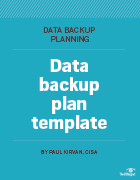Data backup plan template: A free download and guide
Download our free backup planning template to help you get started or improve your current plan. It's important to have critical information laid out in a document.
Even though most IT organizations perform data backups daily, they may not have a formal documented data backup plan, which is a key piece of the puzzle.
The data backup plan defines the overall process for backing up data, databases, systems, applications and other information resources. The data administration team generates daily reports on backup activities, specifying what it backed up, the locations, date and time of the backup, and if it was successful.
The tips here will help you prepare a basic plan. The associated backup plan template will help you complete a plan.
Importance of a data backup plan
The backup plan provides a repository for relevant information about the overall backup process. Items your organization can add to a backup plan include the corporate policy for backing up data, lists of backup team members, lists of vendors and their contact data, general procedures for backing up data, and metrics for measuring overall data backup performance.
Having a data backup plan is also important from an audit perspective. IT auditors generally look for evidence of controls that manage specific IT functions. You can use a data backup plan to define such controls. While the plan is not necessarily used as a daily document, it can serve as a framework for performing the all-important data backup function.
The backup plan template
At its most basic level, a data backup plan specifies the overall backup process, what gets backed up, what technologies and storage resources are used, what steps are taken if data is not successfully backed up, plus other items like testing backup procedures, and reviewing and updating the plan.
The associated backup plan template includes the following components. Use them to update an existing plan or create your own plan using the various elements in the template.
- Revision management. Have a page that lists your revision activities.
- Purpose and scope. Provide details on the plan, as well as assumptions, team descriptions and other background information.
- Backup policy. Specify the company policy regarding data backups.
- Performing data backups. This section defines the backup activities to perform and serves as a starting point for developing daily, weekly and monthly backup schedules.
- Data recovery. Notes that a data recovery process is also needed to complement the data backup plan; this can be a stand-alone data recovery plan or it can be part of the overall backup plan.
- Plan review and maintenance. Describe the process for reviewing and maintaining the plan; it can also specify the need for performing tests of the data backup plan.
- Appendices. Detailed appendices are at the end of the backup plan template; these include lists and contact details on all teams, vendors, backup locations, lists of resources to be backed up and other relevant information. It is important to keep this information up to date.
Data backup plan development guidance
As you go through the backup planning process, there are a number of important steps to follow.
- The plan development team should meet with the internal technology team, application team and data administrators, and establish the scope of the plan.
- Brief IT leadership on these meetings so they are properly informed.
- Gather all relevant data backup documents, such as backup schedules, lists of items to be backed up and tape rotation schedules.
- Identify what management feels are the most important data backup issues to the company; for example, speed of backup, adherence to recovery point objective metrics, and out-of-date copies of databases and other resources.
- Review previous history of data backup problems and how the firm handled them.
- Identify what management feels are the most critical IT assets to be backed up and their frequency.
- Determine the maximum time that management can accept if the backed-up data or systems cannot be quickly recovered.
- Identify the data backup, archiving and related procedures currently used.
- Determine when these procedures were last tested to validate their appropriateness.
- Identify vendors' emergency backup support capabilities, if they have ever been used, if they work properly, how much the company is paying for these services, status of service contract, and presence of service-level agreement and if it is used.
- Compile results from all previous data backup assessments into a gap analysis report that identifies what is currently done versus what ought to be done, with recommendations for achieving the required level of backup capabilities.
- Have management review the report and agree on recommended actions.
- Prepare the plans to address data backup, archiving and other data protection activities.
- Conduct tests of backup procedures to validate their operation and that they satisfy any specific backup performance metrics.
- Schedule the next review and audit of the data backup plan.
Important caveats
Be sure to obtain senior management support so that you can achieve your plan goals. Take the data backup planning process seriously, as it is an essential business activity. Once the data backup plan is complete, review it with business units to make sure it addresses their backup requirements.
Finally, be flexible. You can modify the backup plan template in this article as needed to accomplish your goals.

 Click here to download a
Click here to download a






